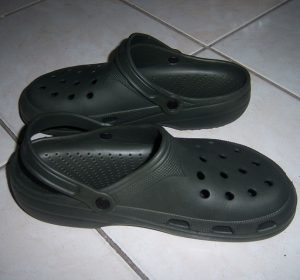 Crocs may be a comfortable and practical option if you’re showering in a public restroom or in a dorm, but like high heels, experts say they aren’t a great option if you have to wear them for long periods of time.
Crocs may be a comfortable and practical option if you’re showering in a public restroom or in a dorm, but like high heels, experts say they aren’t a great option if you have to wear them for long periods of time.
While some people feel Crocs are like the Nickleback of the shoe world, there’s no denying the brand’s popularity, as more than 300 million pairs have been sold since 2002. They can be a suitable option for letting your dog out back for a few minutes, but Dr. Megan Leahy of the Illinois Bone and Joint Institute in Chicago said they shouldn’t be an all-day option.
“Unfortunately, Crocs are not suitable for all-day use,” said Dr. Leahy. “These shoes do not adequately secure the heel. When the heel is unstable, toes tend to grip which can lead to tendonitis, worsening of toe deformities, nail problems, corns and calluses.”
Crocs have a loose backing that can lightly hold the heel in place, but many people flip that strap forward and wear the shoes like slip-on sandals, meaning they often have an unstable heel.
AAPSM Weighs In On Crocs
The American Academy of Podiatric Sports Medicine concurred with Dr. Leahy, saying Crocs can leave a person susceptible to injury because of their limited arch support.
“Patients [who wear Crocs] are more likely to have foot pain if their shoes bend in the shank,” said Dr. Alex Kor, president of the American Academy of Podiatric Sports Medicine “[Crocs] are the poster child for shoes with a flexible shank. … In other words, on a daily basis, I see patients who come into my office complaining of arch or heel pain and they are wearing Crocs.”
So in the end, Crocs wearers should follow some of the same principles we suggested in our sandal guide and high heel wearing guide. They aren’t designed for all day use, so pack a more supportive pair of shoes if you’re going out for the day. If you want to wear them, do so in short intervals, and stop any time you feel pain or discomfort. Contact us if you’ve been wearing Crocs and you’ve noticed that your feet have begun to hurt, as it may be a sign of an underlying condition.